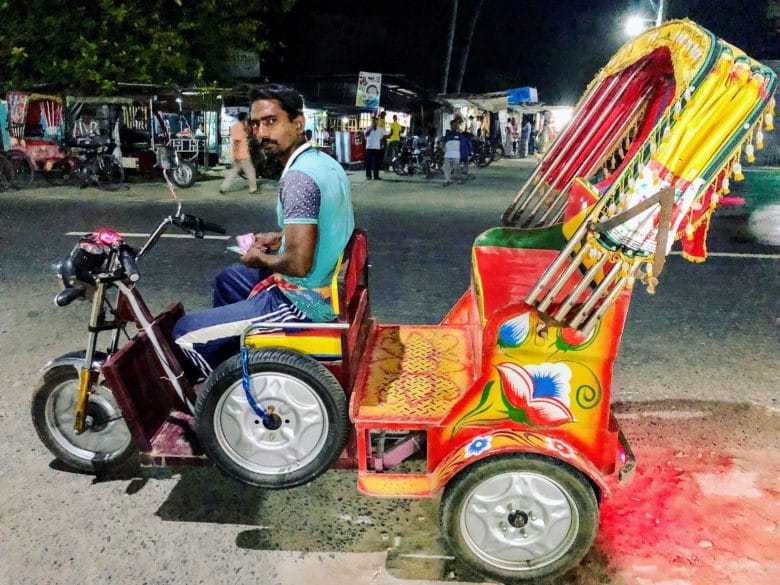I have no objection to BUET designing a rickshaw—the initiative is fine, if done properly! The problem lies elsewhere.
- As far as I’ve heard, the design has been done by teachers and students of the Mechanical Engineering department. The issue is, modern vehicle design cannot be done by mechanical engineers alone, it’s a multi-faceted collaborative task.
Mechanical engineers can work on the engine, speed, wheels, brakes, the mechanical frame of the vehicle. But beyond that, a vehicle also involves the structural integrity of the materials used, metallurgy, tactility, ergonomics, usability and user-experience details, transportation engineering details, electrical and electronics design, and most importantly—safety issues, which require interdisciplinary teams of industry experts for proper design and testing.
For all these, professionals and specialists from various domains are necessary. With just teachers and students of Mechanical Engineering, you might at best produce a basic chassis design. A usable vehicle cannot be built that way. And even if something is built, it should not be released on the road.
This is where my objection lies—that a group of students and teachers are building something and putting it on the street without any serious design process or testing. The audacity with which they assume that just because this is a rickshaw—poor people will drive it, poor people will ride it, and since it will run in a poor city of a poor country where unregulated things already operate that they can just build anything and toss it on the road, and it will be a noble contribution to society—this mindset is not just problematic, it directly conflicts with their own professionalism and academic ethics. Going out to “fix” the rickshaw with such an approach feels like a bandaid solution to me, not something an esteemed university like BUET should embark on.
If you truly want to design something as a last-mile door-to-door connector vehicle for Dhaka’s roads, which the city actually has a serious demand of, do it properly! Involve everyone. Call in the right people for the right roles. Bring in experts. And please, stop this self-righteous bravado. Launch an international design competition. Invite diverse experts. Do proper safety design and testing.
If you try to build something in a cottage-industry style, what you’ll end up with is another Nosimon-Karimon, nothing better than that. Designing a new vehicle isn’t that easy, and if you are not designing a new vehicle, the streets don’t need you. That’s not how the world works. For example, you put a door on the rickshaw, why? How many people of different demographics of age, gender and physical abilities did you do ergonomic testing with? Did you provide proper ventilation with that door? Are there windows that can open and close, or built-in fans? In an emergency, how do you open the door from inside? If the vehicle flips over in an accident, how do people get out? And if people die because of a design flaw, who will take responsibility? What kind of battery is being used? What’s the fire rating of that battery? What’s the environmental rating?
You are academics, if you take the audacious step of putting a vehicle on the road without answering these questions, then your education and professionalism will be under microscope.
- There are actually several versions of vernacular organic designs that (at first glance) seem quite good. For example, look at the design in the photo above. What’s currently running on Dhaka roads is mostly old rickshaws with battery motors slapped on—extremely dangerous! But the one in the photo seems better with thick tyres, brakes on all three wheels, brake pedal operated by foot like a car, fairly natural acceleration, attempted suspension, quite sturdy and comfortable. I’ve seen these running all over Rajshahi for years. Compared to that, BUET Mechanical’s design, from what I’ve seen in photos, looks even more flimsy and disproportionate. Ground-tested vernacular designs are actually better than these kinds of untested academic experiments.
Ultimately, in a civilised city, rickshaws should have no necessity. And rickshaws are not the vehicle of the poor, they are in fact, quite expensive. Rickshaw drivers are not helpless poor people (relatively speaking); they receive extra sympathy due to proximity bias. For example, you don’t see the labour of all the people who worked tirelessly from seedling to plate to bring you the rice you eat. Since they’re not in your immediate surroundings, you don’t tip them like you would a rickshaw puller—simply because they are not near you. The distances we travel by rickshaw are almost all walkable. Try walking!
That said, I also admit — rickshaws won’t be phased out overnight. And whatever the alternative will be, BUET’s Mechanical students and teachers won’t be able to cook it up in a lab as a side project. That will require a larger mobilisation — research, design, and initiative. It will require improvements in public transport and walkable infrastructure in the city.
বুয়েট রিকশা ডিজাইন করছে সেটা নিয়ে কোন আপত্তি নাই, উদ্যোগ তো ভালোই যদি ঠিকঠাক মত কাজটা করা হয়! সমস্যা হচ্ছে,
১। যতদূর শুনেছি, ডিজাইনটা করেছেন মেকানিক্যালের শিক্ষক ও ছাত্ররা। মুশকিল হলো, আধুনিক যানবাহনের ডিজাইন শুধু মাত্র যন্ত্রকৌশল প্রকৌশলী তৈরি করতে পারে না, এটা একটা বহুমুখী কোলাবোরেটিভ কাজ।
যন্ত্রকৌশল প্রকৌশলী ইঞ্জিন, গতি, চাকা, ব্রেক, যন্ত্রের কাঠামো এগুলো নিয়ে কাজ করতে পারে। কিন্তু একটি বাহনে এর বাইরে আছে ব্যবহৃত উপাদানের স্ট্রাকচারাল ইন্টেগ্রিটি, মেটালার্জি, ট্যাকটিলিটি, আর্গোনোমিক্স, ব্যবহারযোগ্যতার ডিটেল, পরিবহণ-প্রকৌশল সংক্রান্ত ডিটেল, ইলেকট্রিক্যাল এবং ইলেকট্রনিক্স ডিজাইন, এবং সর্বোপরি—মহাগুরুত্বপূর্ণ—সেফটি ইস্যু, যা ডিজাইন ও পরীক্ষা কারার জন্য প্রয়োজন ইন্ডাস্ট্রি এক্সপার্ট ইন্টার-ডিসিপ্লিনারি লোকবল।
এগুলো সবকিছুর জন্য বিভিন্ন ধরনের পেশাজীবী এবং বিশেষজ্ঞ প্রয়োজন। শুধু মেকানিক্যালের ছাত্র-শিক্ষক দিয়ে হয়ত বড়জোর একটা চ্যাসির প্রাথমিক ডিজাইন বানানো সম্ভব, ব্যবহারযোগ্য গাড়ি বানানো সম্ভব না। আর কিছু একটা বানানো সম্ভব হলেও, সেই গাড়ি রাস্তায় নামিয়ে ফেলা উচিত না।
কয়েকজন ছাত্র আর শিক্ষক মিলে কিছু একটা বানিয়ে রাস্তায় ছেড়ে দিচ্ছেন, কোন সিরিয়াস ডিজাইন এবং পরীক্ষা নিরীক্ষা ছাড়া—আমার আপত্তি এখানে। এই যে উনারা অডাসিয়াসলি ধরে নিচ্ছেন যে যেহেতু এটা রিকশা, গরিব মানুষরা চালাবে, গরিব মানুষরা চড়বে, গরিব দেশের গরিব শহরে চলবে, রাস্তায় যেহেতু ইতোমধ্যে অনিয়ন্ত্রিতভাবে চলছে, তাই কোন রকমে একটা কিছু বানিয়ে ঠাশ করে রাস্তায় নামিয়ে দিলেই সমাজের প্রতি মহান একটা কন্ট্রিবিউশন হবে—এই চিন্তাধারা শুধু প্রবলেম্যাটিক না, বরং উনাদের প্রফেশনালিজম এবং অ্যাকাডেমিক নৈতিকতার সাথে সাংঘর্ষিক। রিক্সার ডিজাইন “ঠিক করার উদ্যোগ” নিয়ে মাঠে নামাটাকে একটা তালি-পট্টি দেওয়া কাজ (bandaid solution) বলে মনে হয়।
যদি ঢাকার রাস্তার last-mile door to door connector vehicle হিসেবে কিছু একটা ডিজাইন করতেই চান তাহলে ভালো মত করুন! সবাইকে নিয়ে করুন, যার যেটা কাজ তাকে ডাকুন, বিশেষজ্ঞদের সাথে নিন, এবং আলগা মাতব্বরি ছাড়ুন। আন্তর্জাতিক ডিজাইন প্রতিযোগিতা করুন, বহুমুখী এক্সপোর্টদের দাওয়াত দিন। প্রোপার সেফটি ডিজাইন ও টেস্ট করুন।
নিজেরা মাতবরি করে কুটির শিল্প স্টাইলে যা বানাবেন তা নসিমোন করিমোনই হবে, তার চেয়ে ভালো কিছু হবে না। একটা নতুন ভিয়াকল ডিজাইন করে ফেলা এত সোজা না। দুনিয়া এভাবে চলে না। এই যে রিকশায় একটা দরজা দিয়ে দিলেন, কেন দিলেন? কতজন ভিন্ন ডেমোগ্রাফির মানুষ নিয়ে আর্গোনোমিক টেস্ট করেছেন? দরজার সঙ্গে কি পর্যাপ্ত ভেন্টিলেশন ব্যবস্থা রেখেছেন? জানালার খোলা-বন্ধ ব্যবস্থা বা ইন-বিল্ট ফ্যান আছে কি? দরজা জরুরি প্রয়োজনে ভেতর থেকে কীভাবে খুলে? অ্যাকসিডেন্ট করে উল্টে পড়ে থাকলে মানুষ কীভাবে বের হবে? অ্যাকসিডেন্টের পর আপনাদের ডিজাইনের ভুলের কারণে মানুষ মারা গেলে তার দায় কে নিবে? কী ধরনের ব্যাটারি ব্যবহার হচ্ছে? সেটার ফায়ার রেটিং কী? ব্যাটারির পরিবেশগত রেটিং কী?
আপনারা অ্যাকাডেমিক, আপনারা যদি এসব উত্তর না দিয়ে রাস্তায় গাড়ি নামিয়ে ফেলার দুঃসাহস দেখান তাহলে আপনাদের শিক্ষা এবং প্রফেশনালিজম নিয়ে সন্দেহ তো তৈরি হবেই।
২। ভার্নাকুলার অর্গানিক ডিজাইনেরই বেশ কিছু ভার্শন আছে যা (আপাত দৃষ্টিতে) বেশ ভালো বলে মনে হয়। যেমন উপরের ছবির ডিজাইনটা দেখেন। ঢাকার রাস্তায় যা চলছে এখন তা হলো পুরোনো রিকশায় ব্যাটারি মোটর লাগিয়ে চালিয়ে দেওয়া, খুব বিপজ্জনক! কিন্তু ছবির ডিজাইনটা বেটার বলে মনে হয়, মোটা চাকা, তিন চাকাতেই ব্রেক আছে, ব্রেক পেডাল গাড়ির মত পায়ে, এক্সেলারেশন বেশ স্বাভাবিক, সাসপেনশন দেওয়ার চেষ্টা করেছে, বেশ শক্তপোক্ত আরামদায়ক। পুরো রাজশাহী শহরজুড়ে এগুলো চলতে দেখি অনেক বছর থেকে। বুয়েটের মেকানিক্যালের ডিজাইন ছবিতে দেখে এর চেয়েও ফ্লিমজি এবং ডিসপ্রোপরশনেট মনে হয়েছে। মাঠ পর্যায়ে বহুবছর ধরে চলমান ভার্নাকুলার ডিজাইন বরং এধরনের অ্যাকাডেমিক অপরীক্ষিত কাজের চেয়ে ভালো।
সর্বপরি, একটা সভ্য শহরে রিকশার কোন প্রয়োজনীয়তা থাকতে পারে না। এবং রিকশা গরিবের বাহন না। রিকশা চালকেরাও অসহায় গরিব না (তুলনামূলকভাবে), তারা প্রক্সিমিটি বায়াসের কারণে বাড়তি মায়া মহব্বত পায়। যেমন, আপনি যে চালের ভাত খান, সেই চাল, ধানের চারা থেকে আপনার থালা পর্যন্ত আসতে যে পরিমাণ মানুষ অক্লান্ত পরিশ্রম করে, তাদেরকে আপনি দেখেন না, সেই জন্য তাদের শ্রমের মূল্য আপনি রিকশার মত পাঁচ টাকা বাড়িয়ে দেন না, কারণ তারা আপনার আশেপাশে নাই। আর রিকশা যে দূরত্বে চড়া হয় সেগুলো প্রায় সব হাঁটার যোগ্য দূরত্ব। হাঁটুন!
তবে এটাও মানি, রিকশা রাতারাতি বন্ধ করে দেওয়াটা হয়ত সহজ হবে না। আর এর বিকল্প কী হবে সেই সমাধান অন্তত বুয়েটের মেকানিক্যালের ছাত্র-শিক্ষকেরা তাদের ল্যাবে বসে শখের বসে বানিয়ে দিতে পারবে না। তার জন্য আরও বড় আয়োজন লাগবে, গবেষণা, ডিজাইন, উদ্যোগ লাগবে। শহরের গণপরিবহন এবং হাঁটাপথের উন্নয়ন লাগবে।



